Editorial Guidelines
This page serves as the main resource for explaining how we create, structure, style, and maintain content for 7datarecovery.com. Our content follows these guidelines to ensure everything we publish meets a consistent standard that best represents the goal of our website.
Our focus is simple: to help our readers recover their data. As our readers come from all walks of life, we must ensure that our content is of high quality and easy to understand, so as not to complicate their specific situation further. To do this, we follow a carefully crafted editorial process.
Our Content Strategy
The majority of our content consists of “How to” articles that primarily focus on data recovery following an issue with a storage device. We also occasionally create software rankings to aid our readers in selecting the right software tools for their situation, as it presents the reader with a list of suitable options, along with their strengths and weaknesses.
We do not earn any commission from the vendors that we include in our articles or rankings, and the selection relies solely on the author’s opinion. Learn more about our review process here.
Brand Voice
To make certain that our content gets across to all of our readers, we use an approachable, concise tone that prioritizes clarity. Using complicated language and unnecessary jargon makes it harder for readers to follow along and may cause them to seek answers elsewhere, especially if they’re not technically inclined.
To keep our readers engaged, we use straightforward language and provide brief explanations of any technical terms that we use. We also link out to external resources, as it’s a good way of providing the reader with additional material if the concept is quite intimidating or challenging, even when simplified.
Here’s an example introducing CHKDSK, explaining its function, and why we included it in that particular article:
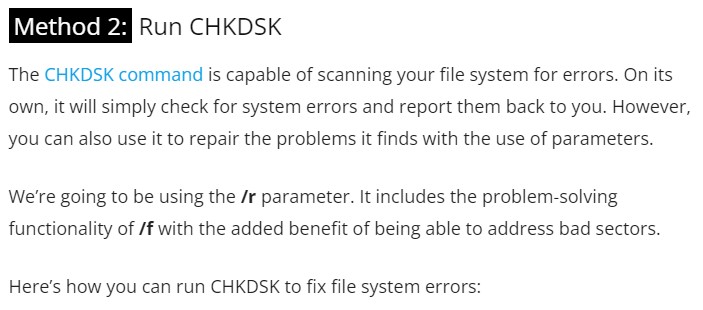
Here’s another example, this time introducing and explaining SFC and DISM to the reader:
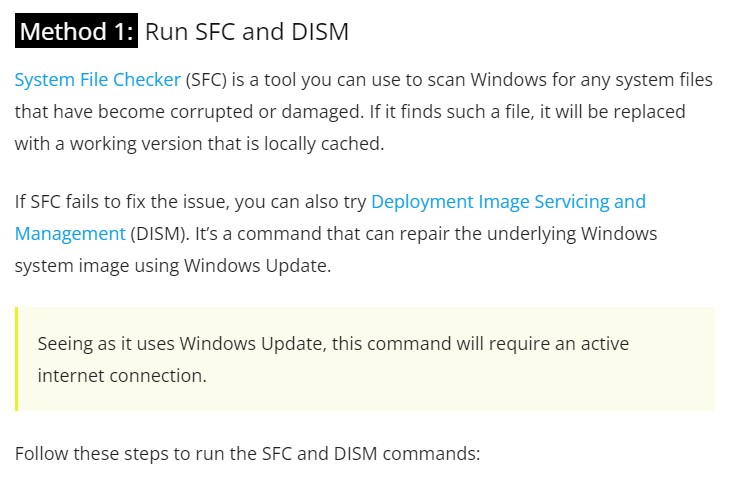
Personal Touch
We encourage our authors to share their personal experiences. Adding a personal touch to the article by sharing personal experiences, insights, or practical tips adds authenticity and helps build a connection with our readers.
How We Plan Content
Our topics focus on data recovery and the data loss issues that can occur on a range of different devices, such as hard drives, solid-state drives, USBs, SD cards, and phones. Even though our core focus is on data recovery, we do sometimes explore other related areas and emerging technologies.
For topic ideas, we seek inspiration from forums and social media to see what questions need answering. We also accept suggestions from our community and writers through our contact page. We research these topics using a range of marketing tools, including Ahrefs, Google Trends, AnswerThePublic, and more. These tools help to formulate a content brief, which is attached to each task item.
Our Writing Guidelines
Our marketing team crafts a content brief for each task that includes all the necessary information for the writer. This includes (but is not limited to):
- An article structure and the angle we wish to approach the topic.
- Supplemental research material.
- A URL slug and category for when the draft is to be moved to WordPress.
- The word count.
- A list of keywords and links to include in the article.
We use Notion for communication. The author can reach out to the marketing team and technical team at any point to get more information for the article.
Our writers adhere to strict writing guidelines. By doing so, we can guarantee that everything we publish meets the standard that our readers deserve.
Writing Style
Our writers use plain English. Plain English is a writing style that prioritizes communicating information clearly and concisely so it is easily understood by a broad audience. This minimizes confusion without compromising quality, which is essential when communicating technical topics.
Using plain English involves:
- Keeping sentences short - Sentences should convey information in a concise manner. Long sentences tend to distract readers, causing them to disengage from the reading material.
- Using ‘you’ and ‘we’ - Using ‘we’ and ‘you’ when referring to us or the reader feels more personalized, like we’re talking directly to the reader.
- Using lists to split up information - Long walls of text are bad at keeping the attention of readers. Instead, we break the information up using bulleted or numbered lists to make it more digestible.
- Prioritizing clear language - We avoid using jargon or overcomplicated words. And, when using technical terms, we briefly explain them in a way that anyone can understand.
All of our articles are written in American English because of the preference of our audience. We do not allow the use of AI technologies for content creation (however, AI technologies can be utilized in other areas, like checking for grammatical mistakes). Furthermore, we do not allow copying content from other online sources. We strive to make all our content unique and original.
In-depth Research
Everything that we publish must be correct. The last thing we want is to provide our readers with misinformation that could put them in a worse position. To achieve the accuracy we strive for, we conduct thorough research for each topic. All instructions included in the post are tested to make certain they’re correct. Furthermore, we urge our writers to do their best to include information that can help answer any potential questions that may arise.
✅ Best research practices:
- Find and link to credible sources. Linking to reliable sources builds credibility and trust with our readers.
- Utilize public forums. Public forums (like Reddit, Quora, Superuser, etc.) provide a more intimate glance into how the issue directly affects users and oftentimes include answers from the community.
- Verify claims and test solutions. Our writers test the solutions on their own devices, as it helps build a well-rounded understanding of the problem but also provides an opportunity to get original screenshots.
- Use fresh information. We advise our writers to always check when resources were last updated. Including outdated information can cause the reader to become confused, like if particular options are omitted.
Headlines
We are adamantly against the use of clickbait in our content. We want to remain a trusted source of information in the data recovery space. Therefore, all article headlines need to be clear, precise, and accurately reflect the contents of the article. This is also true for sub-headings, as it allows readers to quickly scan content and find the information they need. We use AP Style Title Case for headings and encourage our writers to make use of TitleCase to assist with formatting when unsure.
In each content brief, our marketing team includes a structure of the article that logically separates content using sub-headings (H2, H3, and H4). These headings allow users to quickly scan the content and find what they’re looking for. Our blog page is a good place to see some examples of our headings.
✅ Optiminal heading practices:
- Descriptive wording. It should be clear what the reader can expect in each section so they can easily find what they’re searching for.
- Simple formatting. Sub-headings don’t need to be in bold or italics. We have our own design elements that can be applied when the article is ready for WordPress.
- Concise headings. Headings should be long enough to explain what the section is about but short enough that they don’t look jarring.
- Proper heading structure. All headings should follow an H2, H3, and H4 hierarchy to logically separate the content.
Structure and Formatting
When structuring and formatting an article, we like to put ourselves in the shoes of our readers to see how the content comes across. In doing so, we can think like a user and anticipate what topic-related questions may come to mind and how to best structure the content so it’s useful.
Our content follows a specific structure and format that is optimized for readability to keep the reader engaged. One critical component of this is the introduction. The introduction of the article sets the basis for what the article is about and motivates the reader to continue further, so it’s important that it’s related to the headline and confirms what the reader should expect.
The article will be broken down into logical sections, separated by headings. At the beginning and end of each section, we encourage our writers to use language that will smoothly transition the reader to the next part of the article. Here’s an example of transitioning to another section by referencing what was discussed in the previous section and what’s going to be covered in the next:
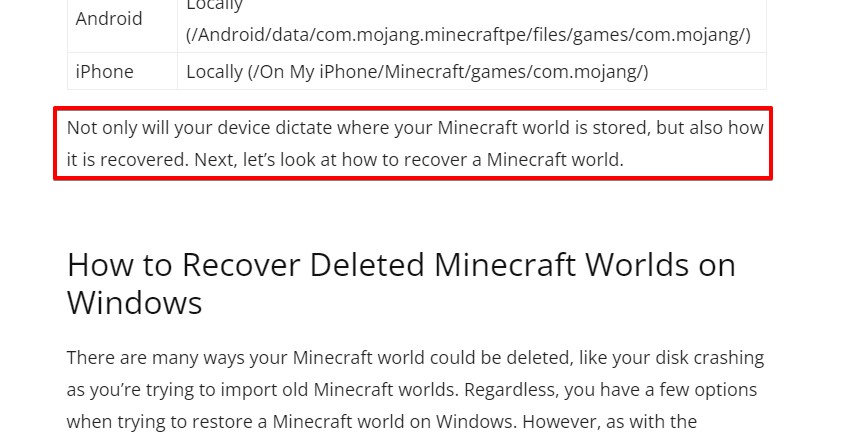
We also welcome the use of side notes. Side notes are a useful way of giving the reader more information on a topic. They’re also a great way to break up long walls of text. Here’s an example of a side note:
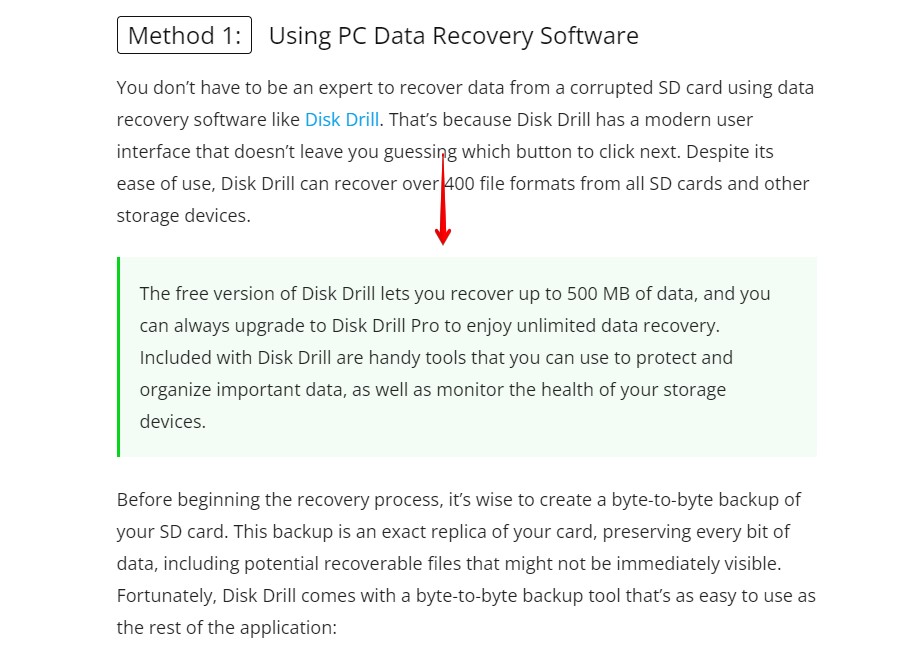
Linking Strategies
When making claims or explaining certain aspects of a subject, our writers link out to external resources to provide additional information on the topic for the readers. Our writers do their due diligence to ensure the resource they’re linking to is a credible, reliable source that will benefit the user by providing useful information.
We try to include relevant links to our other articles in content briefs. In general, it’s good practice to link to other existing pages on 7datarecovery.com where possible to encourage the reader to see some of our other content.
Internal links should be applied to relevant anchor text. This means the text should indicate what the page is about by using the linked article heading. For example, let’s say one of our writers is tasked with linking to this article:
Our Editing and Review Process
Articles go through a thorough, multi-step review process before they’re published. This helps to reduce the chance of inaccuracies making their way to publication. Here’s a brief walkthrough of the entire editorial process:
Step 1: Task assignment. A member of our marketing team assigns a task to the writer. The task will include information about the topic of the article.
Step 2: Drafting the article. The writer researches the topic and crafts the draft according to our writing guidelines.
Step 3: Task provider check. The task provider checks the article and provides feedback by leaving comments and suggestions in the Google Doc.
Step 4: QA specialist check. A QA specialist checks the article to ensure all technical information is accurate and provides feedback if necessary.
Step 5: Editing. Once these checks are complete, the writer makes revisions according to the feedback that was left.
Step 6: Additional checks. Following revisions, the task provider checks the article again and makes sure that the flow of the text is smooth and that the article is free of grammatical mistakes and typos. In some instances, an additional check by a QA specialist will be done.
Step 7: Add to WordPress. Once everything is approved, the writer uploads the article as a draft to our Content Management System (CMS).
Step 8: Final check and publication. The draft in CMS receives one final check-over. If all is good, the article is published.
Our Content Design Guidelines
To make sure our content is attractive to readers, we have certain content design guidelines that help make our content ‘pop’. These guidelines dictate how the content will look once the article is published.
Image Selection
Images are a great way to help the reader follow along and act as a visual aid to accompany text instructions. Therefore, we request that all of our writers include images where needed, like when listing instructions.
Writers make sure that all images are clear and accurately display what they’re trying to capture. To help with this, we use arrows and boxes to point out what the reader needs to pay attention to. One tool that’s good for this is Monosnap.
Here is an example of screenshots being used to complement step-by-step instructions:
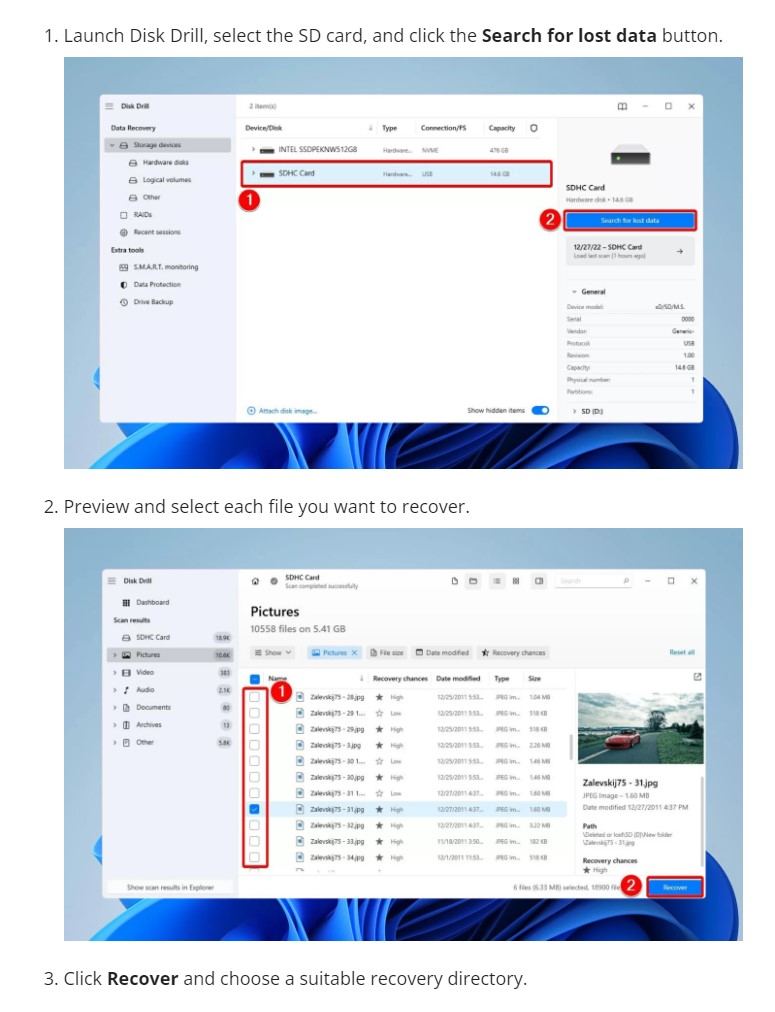
All images are cropped to leave some space around the window that is being captured (as per the example). The images should be no less than 1200 px in width to account for viewing on all devices (mobiles, tablets, and computers) that use different screen sizes and resolutions. We avoid using stock images and don’t take media from other websites.
Content Chunking
Readers are less likely to stay engaged if they need to read a large wall of text. We dilute large chunks of text with images, lists, and marked text. The below image is a good example of this. Notice how the text is separated into bite-sized paragraphs and includes a bulleted list to break it up.
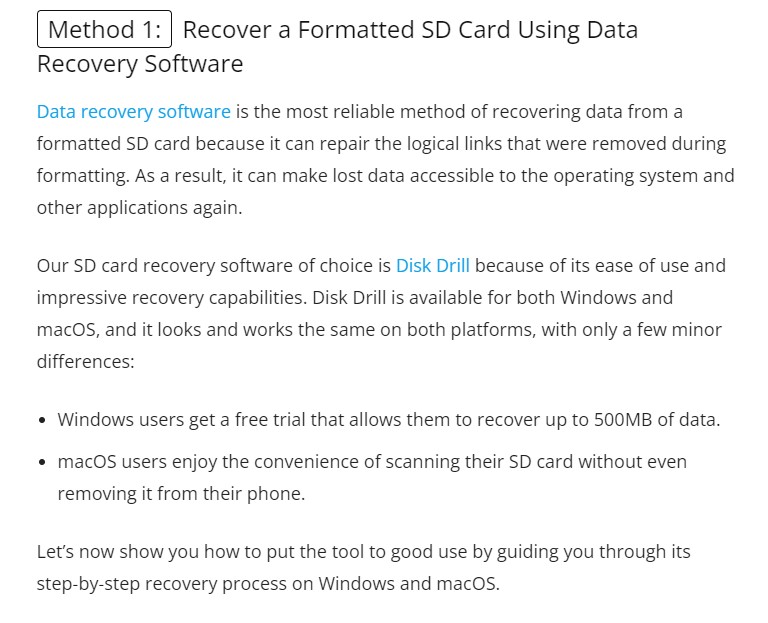
Another method we use to keep the text interesting is by implementing certain design elements. We do this using code, which can be applied when the draft is in WordPress. For example, keyboard shortcuts are given button styling, and commands are highlighted, like so:

Mobile Optimization
We take mobile users into consideration when adding the final design touches to their article. Things like responsive design, mobile-friendly navigation, and multimedia elements that work well on smaller screens go a long way in making sure the user experience is great for mobile users.
How We Approach Updates and Revisions
We do our best to make sure all of our content is up-to-date. Typically, we review our content once every several months, but this depends on the type of content. Software rankings require updates more often to account for software updates and new features that have been introduced.
When we review our content, we:
- Verify the facts, statistics, and instructions
- Assess the relevance of the content according to the current context and audience needs
- Check the links to make sure they’re still valid and relevant
- Improve readability and formatting
- Check the existing images and design elements and add new ones or update existing ones if necessary
There are times when we will perform a mass review of articles. Such instances include:
- The release of a new operating system version
- A major update of an existing tool or the release of a new one
- A change in industry trends
- Content consolidation
- User feedback
We encourage our readers to leave feedback regarding the content that we publish. Readers can contact us using our contact page or by email at help@7datarecovery.com.